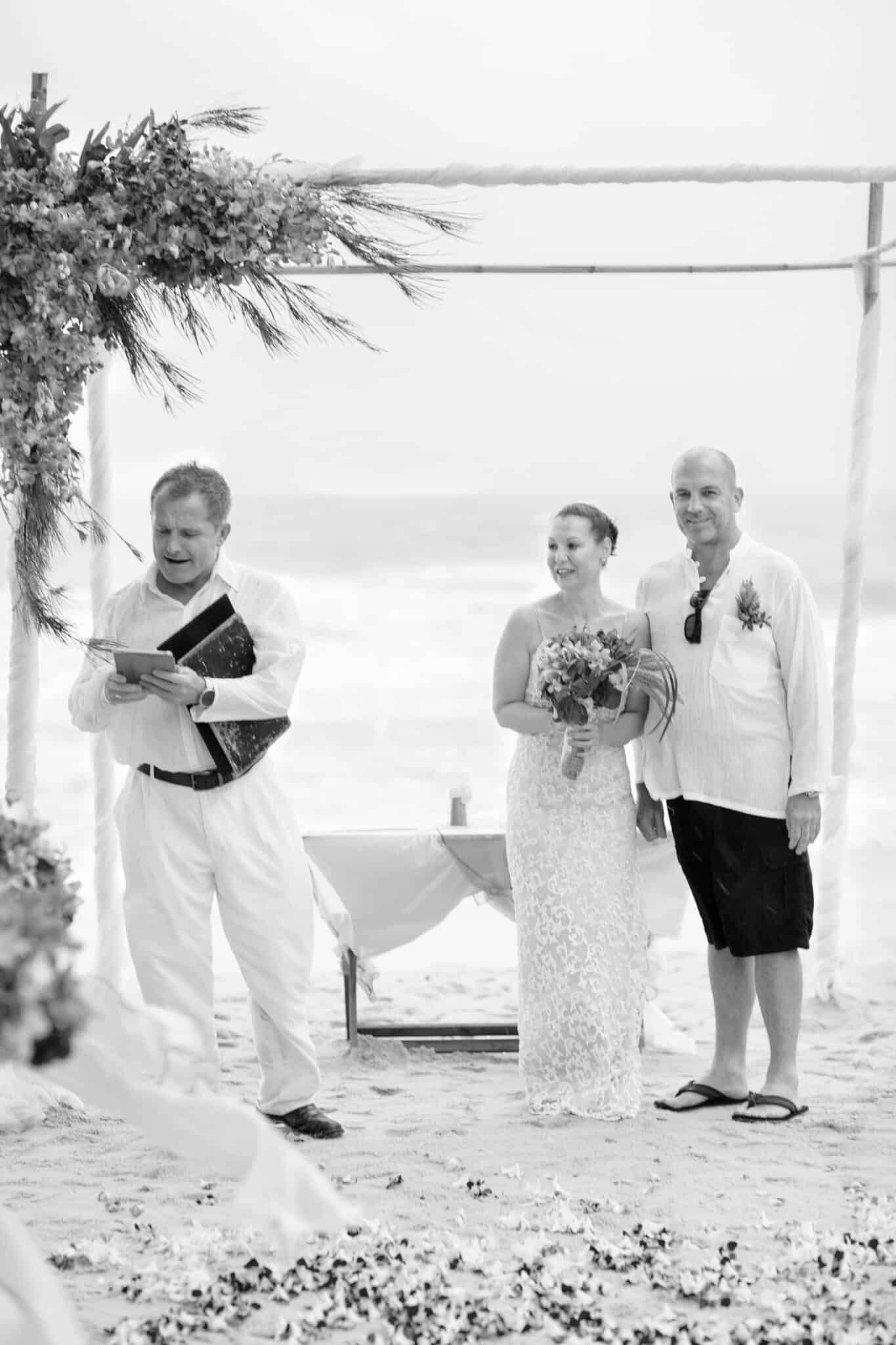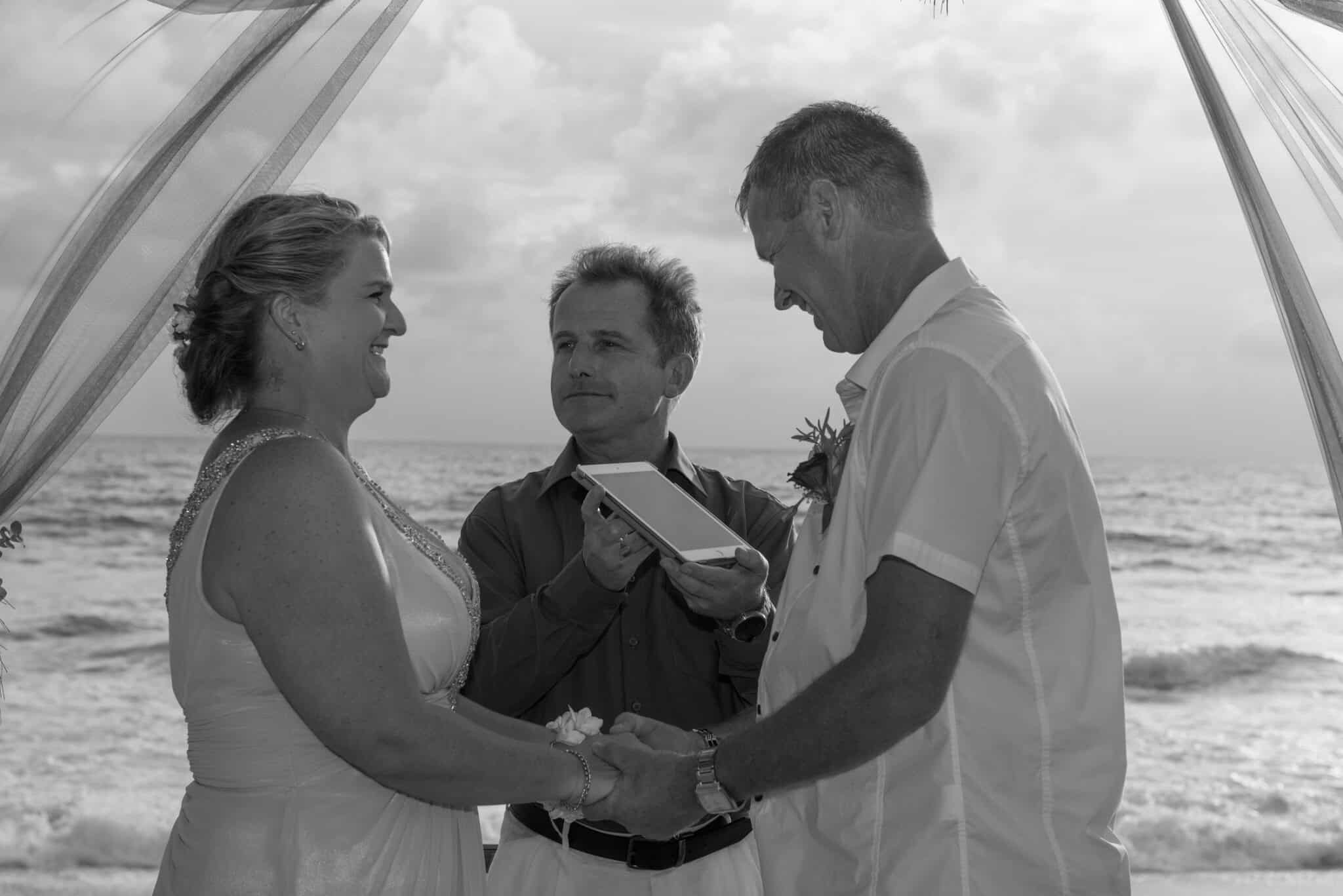As the one who presides over a couple’s marital vows, the officiant plays one of the most important roles in a wedding ceremony. “They have the distinct honor of joining two people’s lives together while surrounded by the couple’s most-loved family and friends,” says Lindsay Terranova of The Boston Bridal Stylist. However, while being an officiant ranks high on the list of wedding roles, it does come with its fair share of responsibilities. Aside from getting ordained, creating the script, and practicing a few public speaking skills, deciding on a celebratory outfit is another essential task to keep in mind before conducting a non-religious ceremony.
If you’ve been asked to officiate a wedding, it should come as no surprise that all eyes will be focused on you. After all, you are the one marrying the couple of honor. You’ll most likely be standing in the middle of the altar (and as a result, in the middle of every photo), so it’s absolutely important to give your outfit a little extra love before taking center stage. And for those who need some guidance when choosing their day-of attire, below are the best expert-approved fashion tips for every secular officiant to keep in mind.
Meet the Expert
- Lindsay Terranova is a personal bridal stylist and the owner of The Boston Bridal Stylist. She’s been working in the bridal fashion space for more than 15 years.
- Lea Stafford is a wedding planner with 14 years of experience, and the owner of Lea Stafford Events based in Northern California. She’s also the founder of Ethos West Collective, which highlights black professionals in the wedding and event industry.
- Julie Sabatino is the founder of The Stylish Bride, which is located in New York. She has 20 years of experience in wedding fashion.
How to Decide What to Wear
First and foremost, you’ll need to touch base with the couple about the dress code since that will determine the level of formality. For instance, if you’re officiating a black-tie event, a floor-length evening gown and a tuxedo are the best options, according to planner Lea Stafford. For cocktail weddings, midi-length or tea-length dresses and a suit and tie are elevated choices. Officiating a semi-formal affair? Terranova recommends wearing a below-the-knee dress, a nice skirt and blouse, or a dress shirt and slacks.
Once you’ve locked in the dress code, the rest should be simple. Ultimately, your next steps should be influenced by the venue, theme, season, and standard wedding fashion style rules.
Consider the Venue
The ceremony site is a major factor that can affect how you dress. Terranova shares that “an evening wedding at a hotel in the city will likely require more formal attire, while a daytime beach wedding could call for a more relaxed look.” For more practical purposes, scoping out the locale will also help you select appropriate shoes based on the landscape. If the couple is saying “I do” on a lawn, in the sand, or on rocky terrain, sky-high stilettos won’t cut it. Instead, opt for sturdier shoes, such as flats, sneakers, wedges, or block heels.
Lastly, one important thing to remember is that regardless of the location, you should still ask the couple about their overall preferences. They might ask you to wear a color that complements their chosen backdrop, or may have you steer clear of a certain look that clashes with their locale.
Look to the Season
Knowing the weather before finalizing your attire is a must, especially if the event is taking place in the great outdoors. “You want to be cognizant of that because you need to be comfortable and focused on the ceremony, and not on the fact that you’re boiling or freezing,” Julie Sabatino of The Stylish Bride explains. Failing to wear weather-appropriate clothes will not only be an unpleasant experience for you, but it will also be a distraction for the other guests. No one will be able to pay attention if you’re constantly wiping sweat away or if your teeth are chattering.
For cold-weather nuptials, Terranova suggests layering your outfit with sweaters or jackets, and using rich fabrics like velvet and brocade to keep you warm. If the duo is trading vows in the spring or summer, the stylist recommends sticking to breathable fabrics like linen and cotton. The warmer seasons are also a great opportunity to experiment with fun colors and patterns, such as a floral dress or a cream suit.
Coordinate With the Wedding Party
As a member of the wedding party, you’ll want to complement the rest of the squad without replicating their exact outfits. Sabatino recommends asking the couple to confirm their color palette, so your getup contributes to a cohesive look while still maintaining your own personal edge. For example, if the bride’s group is donning pink silk dresses, choose a gown in a similar shade. Your goal is to ultimately blend in without being mistaken for a bridesmaid or groomsman.
Keep It Professional
Since the ceremony is all about the couple and their love, the last thing you want to do is overshadow their special moment with an overly bold ensemble. “The role of the officiant is to be the supporting act, not the main attraction,” Terranova notes. “They should be dressed well and feel good in what they are wearing, but they should be sure that whatever they choose to wear will not be a distraction from the couple.” Select something professional and appropriate, and avoid any looks that contain super short hemlines, revealing cuts and silhouettes, or attention-grabbing pieces.
Be Mindful of Certain Colors
In general, there are a few shades you’ll want to stay away from when officiating any wedding. Unless there’s a specific dress code requirement, ditch the color white, Terranova advises, as that is solely a hue reserved for the bride. Another color that’s off-limits? Anything neon, unless, of course, the wedding party is clad in electric tones. “Sticking to a solid dark and/or neutral tone is safe in most cases,” Stafford says.
Infuse Your Own Personal Style
You could follow every fashion etiquette rule to a T, but if you don’t choose a look that makes you feel comfortable and confident, you won’t be able to do your job to the best of your ability. Your role as an officiant requires you to fully concentrate on the couple, so tugging at your waistband or feeling self-conscious about your neckline will make the experience less than pleasant.
To wear something that feels like you, all while maintaining a level of professionalism, Terranova suggests adding your own personal touch with accessories. “Bringing a bit of personality with a piece of jewelry, or a subtle pop of color to a suit with a tie or pocket square can be the finishing touch the outfit needs,” she says.
This content was originally published here.

